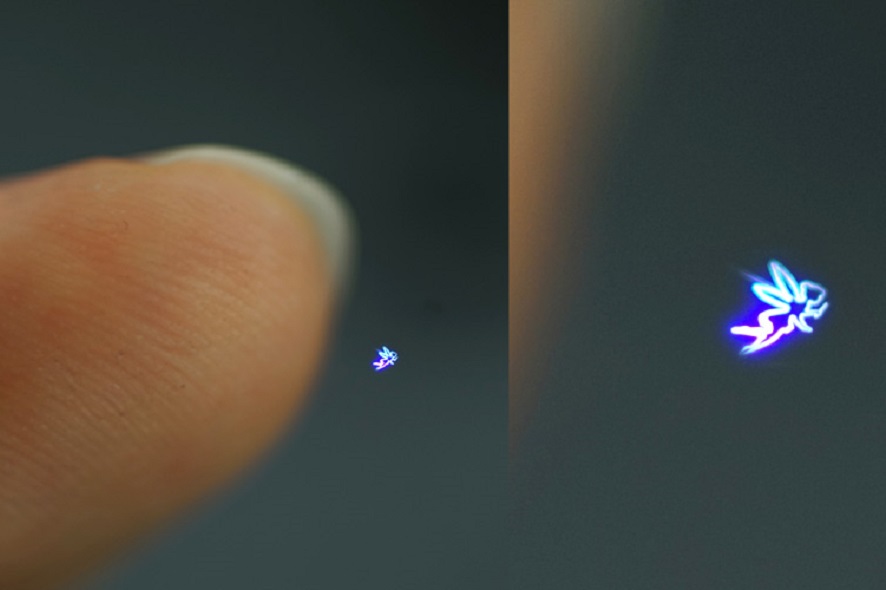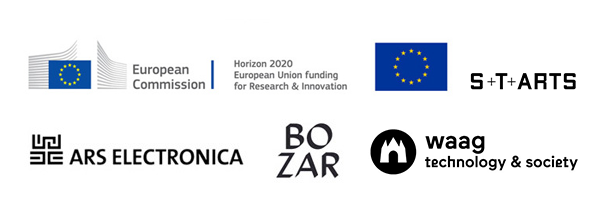The name itself, an acronym of Science, Technology and ARTs, gets right to the point: a prestigious prize—actually two €20,000 grants—awarded annually to single out for recognition exemplary projects at the interface of those three fields. The idea behind it is that encounters of these diverse disciplines engenders great potential for innovation, which is precisely what Europe urgently needs to master the challenges already barreling down on us. Here, the role of catalysts is assigned to artists since they’re the ones who can make scientific and technological concepts accessible by the general public and thereby enable a process of social transformation to get underway.
Entries for prize consideration were accepted in two categories: artistic works that change or influence the way we see technology; and collaborative efforts bringing together industry/technology and art/culture. A jury selected the two prizewinning projects this past spring. The official awards ceremony will be staged in conjunction with the Prix Ars Electronica Gala on September 9, 2016 in Linz.
This year’s grants are going to two extraordinary achievements with great future promise; other honorees and nominees thoroughly reward penetrating scrutiny as well. Here, prior to the big gala, we present for your consideration an interesting selection of 2016 STARTS Prize projects.
One of the nine Artificial Skins and Bones projects: Shortcut.
Art, Bodies and Prostheses: Artificial Skins and Bones
The prizewinning project for innovative collaboration between industry or technology and the art & culture field is entitled “Artificial Skins and Bones” and comes from Germany. To be more precise, the individual works of which it consists were produced within the framework of a seminar at Berlin Weißensee Academy of Art. In cooperation with prosthesis manufacturer Ottobock, seminar participants created nine works having to do with artificial bodies and our relationship to them. They include: textiles that can change their color and pattern; a wearable system that sonifies motion and thereby simplifies the process of training prosthesis wearers to walk; an armband that registers muscle impulses and translates them into computer commands; and an investigation into the extent to which prosthesis materials can appear to be real before other people start to find them “spooky” because they come across as too realistic.
To learn more about the nine projects, read the interview with the seminar leader, Prof. Wolf Jeschonnek, at the Ars Electronica Blog.

Credit: Morgan O’Donovan
Fashion with the Power of Attraction: Magnetic Motion
The first STARTS Prize for artistic research and works that significantly influence how we view technology has been bestowed on Iris van Herpen for her clothing collection entitled Magnetic Motion. The Dutch fashion designer regularly draws inspiration from other disciplines, and Magnetic Motion is no exception. Following a visit to the European Organization for Nuclear Research (CERN), she took as her model the magnetic field of its Large Hadron Collider to create a collection strongly influenced by magnetism and chaos. The respective garments weren’t confected with a sewing machine; instead, Iris van Herpen used injection molding, laser cutting and 3-D printing, whereas her striking accessories were formed by magnets.
One-of-a-kind: The WCMC Discovery Wall
The WCMC Discovery Wall by two British firms, Squint/Opera and Hirsch & Mann, isn’t a common, everyday wall. It consists of 2,800 miniature picture screens, each with a round acrylic disc mounted in front of it. To an observer standing before the wall, the individual images on the monitors almost appear as if they’re inside a ball. But when you step back a bit from the wall, the individual images blend together into a new, bigger picture. The images and animated sequences on display change constantly, and they can be modified and adapted by the users themselves. The WCMC Discovery Wall on Weill Cornell Medical College’s Manhattan campus honors the research work done at the university.
Flying Lamps and a Spark of Magic: SPARKED
Something magical has emerged from the collaboration of Verity Studios, ETH–Swiss Federal Institute of Technology in Zurich, and Cirque du Soleil: “SPARKED,” a playful short film in which lampshades learn to fly and technology seems like a magical force. A repairman sits in his shop and works on a broken lamp when it suddenly shorts out. He sits there, alone in the dark, until the lamps around him come to life and start to dance. The film begins by quoting author Arthur C. Clarke: “Any sufficiently advanced technology is indistinguishable from magic.” How true that is becomes very much apparent when the credits roll at the end. It turns out that it wasn’t any sort of animation technology that got these lampshades dancing; precisely controlled drones did the trick!
Play of Colors: RGB | CMY KINETIC
You could spend hours contemplating RGB | CMY KINETIC, a work by Germany-based ART+COM Studios. It’s simply mesmerizing to observe the five mirrored discs as they float through space. They reflect light cast by three spots in the primary colors red, green and blue, and thereby project a constantly shifting play of colors onto the installation space’s floor. The discs are suspended by fine filaments so they seem to be floating. Accompanied by appropriate background music, this produces a well-though-out and coordinated spectacle.

Credit: Yoichi Ochiai
Light That’s Tangible: FairyLightsinFemtoseconds
FairyLightsinFemtoseconds by Japanese media artist Yoichi Ochiai transforms products of the imagination into reality, and it does so not with paintings or statues but with light. Holographic synthesis gives rise to tiny graphics that swarm in the air. So what’s so special about these light projections? The luminous mini-images react to touch and are thus not only visible but tangible too. And this, in turn, creates possibilities for interaction—when you touch it, a whole heart becomes a broken one; the letters LOVE morph into HATE; and the slightest tweak from an installation visitor’s finger sets logos spinning. The artist refers to his new technique as Fairy Lights, and that’s a pretty fair description: the projections are as fine and enchanting as fairy dust must surely be …
Between Madness and Reality: Cold Stares
The music video by artist Nosaj Thing and musician Chance The Rapper is a dance work, video art and a piece of music all in one. “Cold Stares” is a song about the search for the fundamentals of existence, about memories, about the blurring of what really is and what exists only in our minds—profound lyrics expressed in a dark video. In it, the real world is portrayed by two female dancers, and the world of madness and illusion is added in the form of computer-animated sequences. The two realms aren’t interdependent; rather, they bleed and merge into one another, and sometimes this occurs so quickly that you can’t differentiate between them anymore.
Half Garden, half Independent Vehicle: Hortum machina, B
A plant that rolls along the ground—there’s a specific name for this: Hortum machina, B. The work of a British firm, Interactive Architecture Lab, is a foliage-bearing construction that looks like a ball and rolls on its own to a position that optimizes the amount of light the plants receive. Thus, when they need more light, Hortum machina, B moves to a place in the sun; when it’s too hot, it seeks out shade. The way this works is by measuring the electrochemical stimuli of the individual plants and then networking and bundling the results. So you might say that the plants confer to decide which position is best at the moment for the group as a whole—almost like a real organism does.
An Arm You Can Build Yourself: HACKberry
Another nominee is HACKberry, a bionic arm for amputees invented by a Japanese group named exiii (Genta Kondo, Hiroshi Yamaura und Tesuya Konishi). The schematic diagrams for HACKberry are available online as open-source data under a Creative Common license, and it’s simple to produce via 3-D printer. Software developers worldwide can build the motorized hand exactly as specified or they can upgrade and enhance it any way they see fit. This brings forth projects that have the same origin but each one of which is unique and can be customized to the needs of an individual prosthesis wearer.
Interplay of Light and Shadow: Floating Points – Silhouettes
Director duo Hamil Industries and director/illustrator Junior Martinez developed a colored light machine especially for “Silhouettes,” a music video by the musician Floating Points. This device can render captivating forms amidst a dream-like landscape and simultaneously control the master switch, various lights, fog machines and a motion control system that the crew members likewise produced themselves. It took over six months to complete this technically very sophisticated work. The end product is a video that delivers stunning visuals to accompany Floating Points’ sound.
Besides the amazing projects presented here, there’s lots of outstanding stuff among the other STARTS Prize nominees and honorees. Learn more about the works singled out for recognition by the 2016 STARTS Prize at starts-prize.aec.at. And mark your calendar: the 2016 Ars Electronica Festival is set for September 8-12 in Linz, where the STARTS Prize will be one of the featured attractions in the form of exhibitions and speeches. For the venues, go to https://starts-prize.aec.at/en/presentations/.
This project has received funding from the European Union’s Horizon 2020 research and innovation programme under grant agreement No 732019. This publication (communication) reflects the views only of the author, and the European Commission cannot be held responsible for any use which may be made of the information contained therein.

